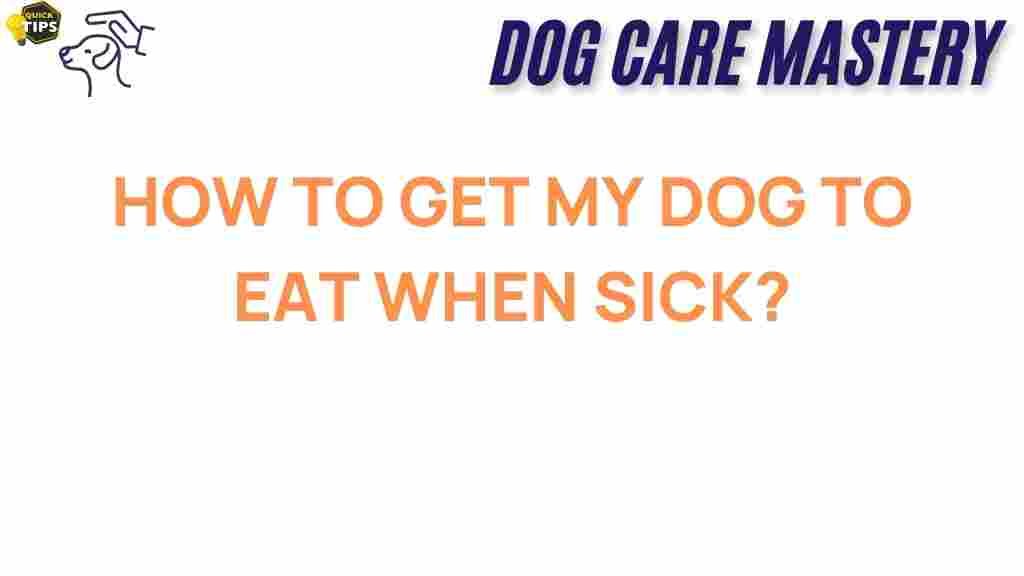Dog Health: Unlocking Secrets to Encourage a Sick Dog to Eat Again
When your beloved furry friend falls ill, it can be a distressing experience for both you and your pet. One of the most concerning issues during such times is a loss of appetite. Ensuring that your dog maintains proper nutrition is crucial for recovery and overall dog health. In this article, we will explore effective strategies to encourage a sick dog to eat again, along with troubleshooting tips to help you navigate this challenging situation.
Understanding the Importance of Nutrition for Dog Health
Just like humans, dogs require a balanced diet to thrive. When dogs are sick, their bodies need additional nutrients to support their immune system and recovery process. A lack of food can lead to weight loss, dehydration, and a weakened immune response, further complicating their health issues. Therefore, encouraging your sick dog to eat is paramount for their well-being.
Step-by-Step Process to Encourage Your Sick Dog to Eat
Here are several effective strategies to help your sick dog regain their appetite:
1. Consult Your Veterinarian
Before trying any methods to encourage your dog to eat, it is essential to consult your veterinarian. They can assess your dog’s condition and recommend appropriate dietary changes or appetite stimulants if necessary. Always prioritize professional advice when dealing with your pet’s health.
2. Offer a Variety of Foods
Sometimes, sick dogs become picky eaters. To entice them, consider offering a variety of foods, including:
- Wet dog food: Canned food is often more palatable and aromatic than dry kibble.
- Homemade meals: Cooked chicken, rice, or pumpkin can be appealing and gentle on the stomach.
- Dog treats: Occasionally, a favorite treat can spark interest in eating.
3. Create a Comfortable Eating Environment
Ensure that your dog’s eating area is calm and inviting. Here are some tips:
- Choose a quiet space away from disturbances.
- Use their favorite bowl to make the experience more familiar.
- Consider warming the food slightly to enhance the aroma.
4. Feed Smaller, Frequent Meals
Instead of offering large meals, try dividing their food into smaller portions and feeding them more frequently throughout the day. This can make eating less overwhelming and may appeal to their reduced appetite.
5. Add Flavor Enhancers
Boosting the flavor of your dog’s food can make it more enticing. Try adding:
- Broth: Low-sodium chicken or beef broth can add moisture and flavor.
- Pumpkin: Plain canned pumpkin is nutritious and can entice picky eaters.
- Plain yogurt: A spoonful of plain yogurt can be a delicious topping.
6. Encourage Eating Through Play
Sometimes, engaging your dog in play can stimulate their appetite. Try incorporating food into a game, such as:
- Using puzzle feeders that require them to work for their food.
- Hiding their food around the house for a scavenger hunt.
7. Be Patient and Observe
It’s important to be patient. Observe your dog’s behavior and reactions to different foods. If they show interest in a particular type of food, focus on offering that more often. Remember, every dog is unique, and what works for one may not work for another.
Troubleshooting Tips
If your dog continues to refuse food despite your best efforts, consider the following troubleshooting tips:
1. Check for Underlying Issues
Sometimes, persistent refusal to eat can indicate underlying health problems. Keep an eye out for:
- Vomiting or diarrhea
- Signs of pain or discomfort
- Lethargy or decreased energy levels
If you notice any of these symptoms, contact your veterinarian immediately.
2. Monitor Hydration
Dehydration can be a serious concern for sick dogs. Ensure that your dog has constant access to fresh water. If they are reluctant to drink, try offering ice cubes or broth to encourage hydration.
3. Avoid Force-Feeding
While it may be tempting to force-feed your dog, this can lead to increased stress and anxiety. Instead, focus on creating a positive eating experience and allow your dog to eat at their own pace.
4. Consider Appetite Stimulants
If your veterinarian deems it necessary, they may recommend appetite stimulants or supplements to help encourage your dog to eat. Always follow their guidance on dosage and usage.
When to Seek Professional Help
If your dog refuses to eat for more than 24 hours, or if you notice any concerning symptoms, it is vital to seek professional help. Early intervention can prevent further complications and support your dog’s recovery.
Conclusion
Encouraging a sick dog to eat again is an essential part of supporting their overall dog health. By understanding the importance of nutrition and employing various strategies, you can help your furry friend regain their appetite. Always remember to consult your veterinarian for personalized advice and support. Together, you can navigate this challenging time and work towards restoring your dog’s health and happiness.
For more information on dog health and nutrition, consider visiting this resource. Additionally, check out our article on common dog health issues to stay informed and proactive about your pet’s well-being.
This article is in the category Health and created by dogcaremastery Team
